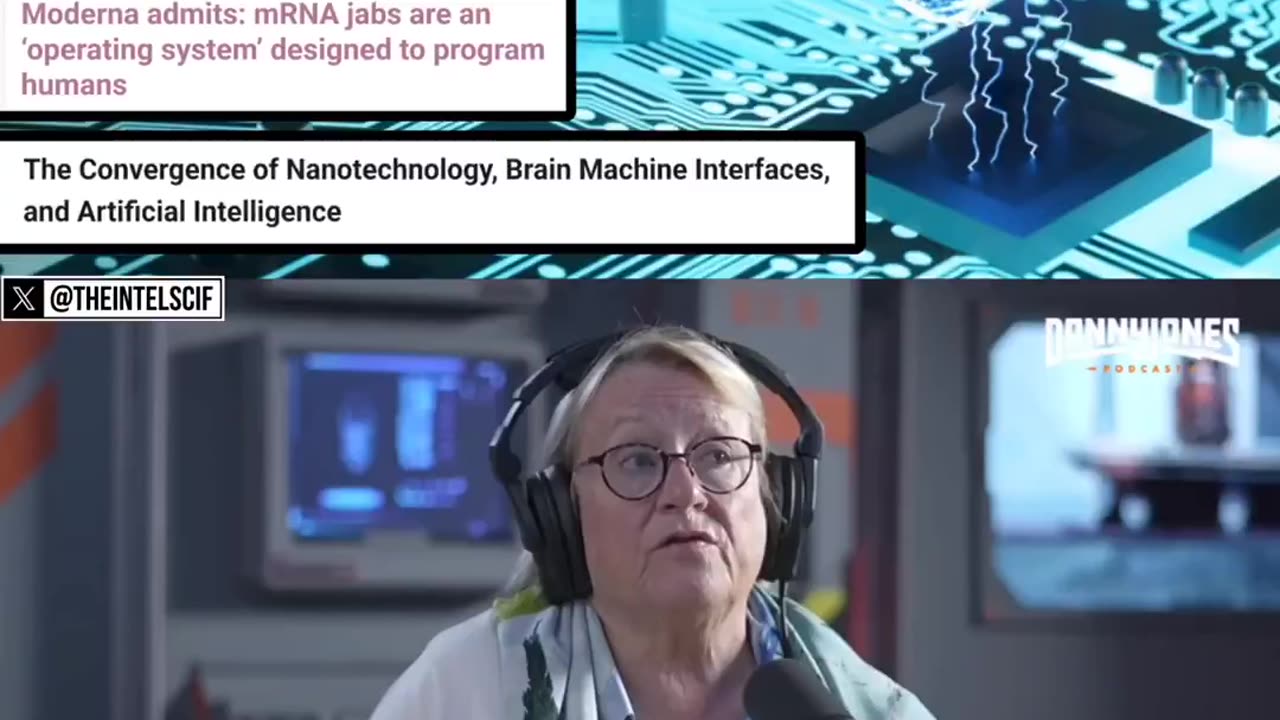Premium Only Content

BRAIN COMPUTER INTERFACE NANOTECHNOLOGY THROUGH mRNA ...
BRAIN COMPUTER INTERFACE NANOTECHNOLOGY THROUGH mRNA VACCINES. Since Moderna called their mRNA jabs an "operating system" designed to program humans, people were confused and nervous. And they should be. The type of tech that these pharmaceutical companies are developing along with other leading companies like the Pentagon's DARPA and many other leading researchers and tech innovators with self-assembling and other types of nanotechnology, developing sensors, electrodes, and BMI devices to enter the body through mRNA vaccines and other methods to have control, monitor, induce behavior, emotions, functions, even read and write to the brain, etc., are literally terrifying. This isn't something that's coming within the next 5 to 10 years. It's already here.
Brain-Computer Interface (BCI), as a cutting-edge technology, refers to the establishment of a direct communication channel between the brain and peripheral electronic devices to realize the efficient information exchange between people and machines.
It in a narrow sense refers to the establishment between the brain and the external environment does not depend on the peripheral nerve and muscle new communication and control channel, by measuring and collecting the central nervous system activity, and its directly translated can be recognized by external artificial equipment signal or instruction, so as to realize the direct communication and control of the brain and external equipment.
Generalized brain computer interface includes input BCI, output BCI and interactive BCI, the input BCI is by external equipment or machine to the brain input electrical, magnetic, acoustic and optical stimulation of brain-computer interface system, output BCI is the signal of the brain into the external equipment control instructions, interactive BCI is by feedback nerve output and input link connected to form a closed loop brain computer interface system.
Nanotechnology plays a key role in the innovative applications of neuroscience and brain computer interfaces. By taking advantage of the unique properties of ministerial, such as high conductivity, biocompatibility and regulation, scientists are able to design more sophisticated and efficient brain-computer interface devices.
These devices can not only realize the precise recording and stimulation of nerve signals, but also promote the repair and regeneration of nerve tissue, providing new tools and means for neuroscience research and clinical application.
Therefore, the innovative application of self-assembling, biodegradable, graphene, etc., nanotechnology in the interface between neuroscience and brain computer technology is gradually promoting the rapid development of this field, providing infinite possibilities for humans to explore the mysteries of the brain and improve the neural function.
Brain-Computer Interfaces (BCIs) enable direct communication between the brain and external devices, but their performance heavily depends on the quality of the electrodes. Traditional materials, such as gold and platinum, offer high conductivity but often struggle with biocompatibility and can cause tissue damage due to their mechanical mismatch with neural tissue.
While conductive polymers provide greater flexibility, they frequently fall short in electrical performance. Nanomaterials, including carbon nanotubes (CNTs) and graphene, are increasingly considered promising alternatives. These materials combine high conductivity with mechanical flexibility and offer potential improvements in biocompatibility, enhancing the capture and transmission of neural signals.
Hybrid materials, which integrate conductive polymers with nanomaterials, have also shown potential by balancing flexibility and signal quality. This review examines recent advancements in nanomaterial-based BCI electrodes and focuses on how these new materials address the limitations of traditional electrodes.
It also discusses emerging tools like metallic nanoparticles and nanowires, along with the ongoing challenges of biocompatibility, tissue integration, and ethical considerations. As nanotechnology continues to evolve, it has the potential to significantly enhance the functionality and longevity of BCIs, making them more effective in facilitating neural communication.
Nanotechnology, as the frontier field of the development of science and technology in the 21st century, is gradually penetrating into the research of neuroscience and brain-computer interface, injecting new vitality and possibilities into this interdisciplinary subject.
With the deepening of human cognition of the brain, neuroscience and brain-computer interface technology has increasingly become a bridge connecting the biological world and the digital world, aiming to interpret the brain information and realize human-computer interaction through advanced technological means, and then promote the innovation of medical treatment, rehabilitation, intelligent control and other fields.
The introduction of nanotechnology provides a different perspective and means to solve the technical problems in the field of neuroscience and brain-computer interface. Antimalarial, with their unique structural characteristics, excellent photoelectric properties and excellent mechanical properties, show great potential in the application of neural interfaces.
In structure, the small size effect of ministerial enables them to combine more closely with nerve cells to reduce tissue damage during implantation. In terms of photoelectric properties, the high electrical conductivity and tunable optical properties of ministerial enable the accurate recording and stimulation of nerve signals.
In mechanical properties, the toughness and elasticity of ministerial ensure their stability and reliability in the long-term implantation process. These improvements in properties not only significantly enhance the biocompatibility of neural interfaces and reduce the risk of immune response, but also greatly improve the transmission efficiency and accuracy of neural signals, laying a solid foundation for the further progress of neuroscience and brain-computer interface technology.
The main nanomaterials in the brain-computer interface is classified according to the organic nanomaterials in the composition, such as carbon nanotubes, graphite and nanoseconds, play an important role in neuroscience and brain-computer interfaces with their superior biocompatibility, high conductivity and lightweight properties.
They need to be able to enhance electrode flexibility, improve signal recording quality and stimulation efficiency. Semiconductor ministerial, such as organic electrochemical transistors, have excellent ionic and electron conduction properties and can serve as an interactive interface between biology and electronics to achieve highly sensitive signal detection.
As a typical spongy and wet material, hydrogel is widely studied and used because of its unique mechanical properties, biocompatibility and ionic conductivity. It can provide a good carrier for a variety of inorganic ministerial and build composites with better performance.
There are also magnetic antiparticle, quantum dots and up conversion antiparticle, which play an important role in advanced imaging technologies and can realize the visualization of specific pathological markers or cellular processes, contributing to the early diagnosis and monitoring of neurodegenerative diseases.
Although these technologies are great for people with disabilities or illnesses, just like many other technologies, it's already being weaponized as developments are already in the process with innovations and numerous methods of control and the monetization of certain aspects throughout this technology.
This is a government's dream weapon and privacy will cease to exists along with your own thoughts. This is the world that is sadly already here and in major development for our society. The part that should scare everyone is that this type of technology and nanomaterial is already in some mRNA vaccines, in our food supply, and being sprayed on us, animals, and our food from above.
Sadly, how much they've been lying to us. Let's just say it wouldn't surprise me if a large amount of people around the globe have some kind of self-assembling, nanotechnology inside them already. Especially the people who took the jabs during covid. I suggest to really do your own research before considering taking any vaccines or shots in general. The writing is on the wall, complete control is the goal, and it's already here.
-
 LIVE
LIVE
Dear America
1 hour agoThis Was Worse Than George Floyd! A Line Has Been Crossed! This Is War!
3,564 watching -
 LIVE
LIVE
Badlands Media
6 hours agoBadlands Daily Sept. 10
3,033 watching -
 LIVE
LIVE
Viss
53 minutes ago🔴LIVE - Sniping Our Way To Victory! - PUBG 101
153 watching -
 LIVE
LIVE
Matt Kohrs
11 hours agoNew Market Highs!!! (ORCL, PLTR, & TSLA & More) || Live Trading Futures & Options
570 watching -
 40:37
40:37
Members Club
53 minutes agoTrump Cheers, Omar Spends, and the Pentagon Rebrands | MC09
-
 LIVE
LIVE
Wendy Bell Radio
5 hours agoENDING THE CAPTURE
7,229 watching -
 LIVE
LIVE
LFA TV
4 hours agoLFA TV ALL DAY STREAM - WEDNESDAY 9/10/25
4,864 watching -
 1:22:44
1:22:44
JULIE GREEN MINISTRIES
3 hours agoLIVE WITH JULIE
66.4K138 -
 LIVE
LIVE
JuicyJohns
2 hours ago $1.17 earned🟢#1 REBIRTH PLAYER 10.2+ KD🟢
113 watching -
 1:03:12
1:03:12
Crypto Power Hour
2 hours agoMaster Your Crypto, The Ultimate Wallet Guide
4.86K6